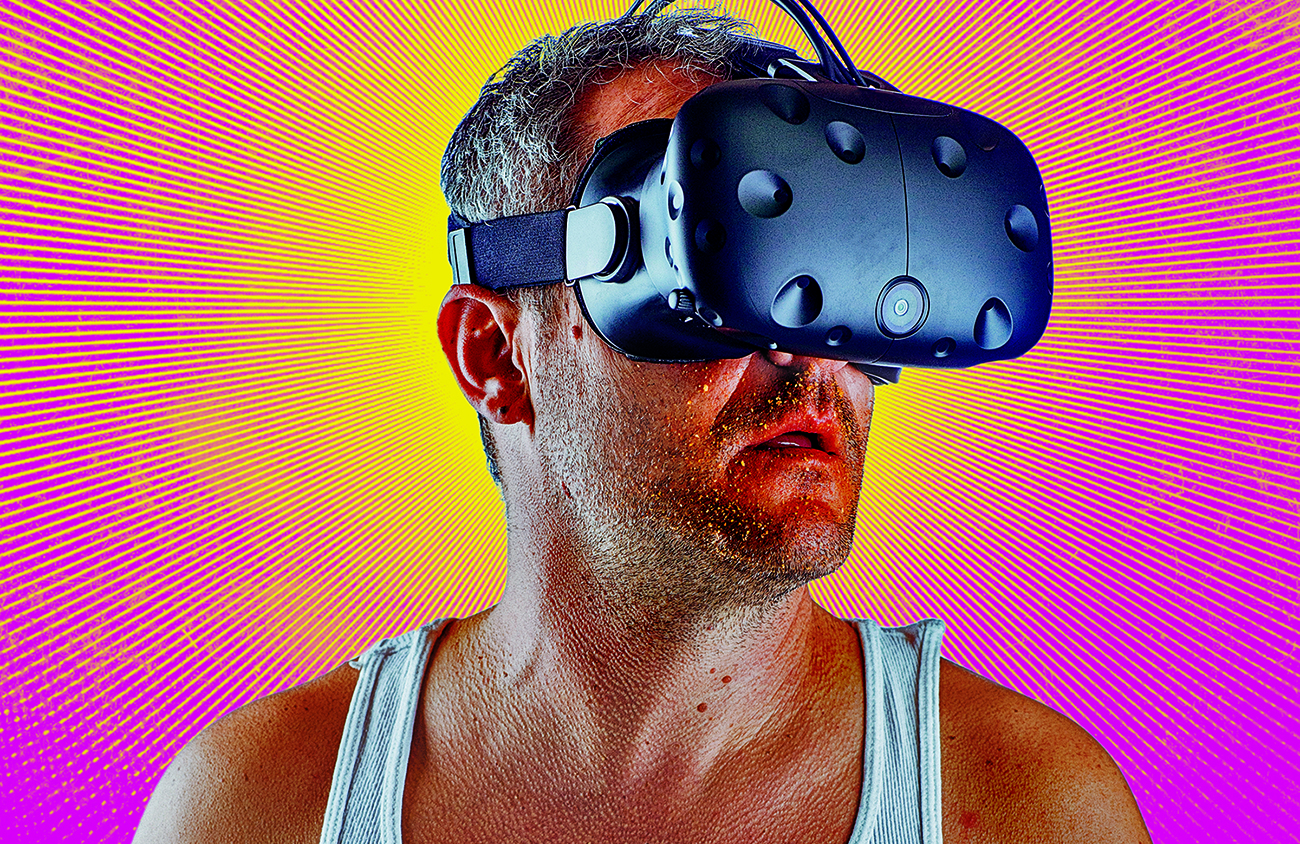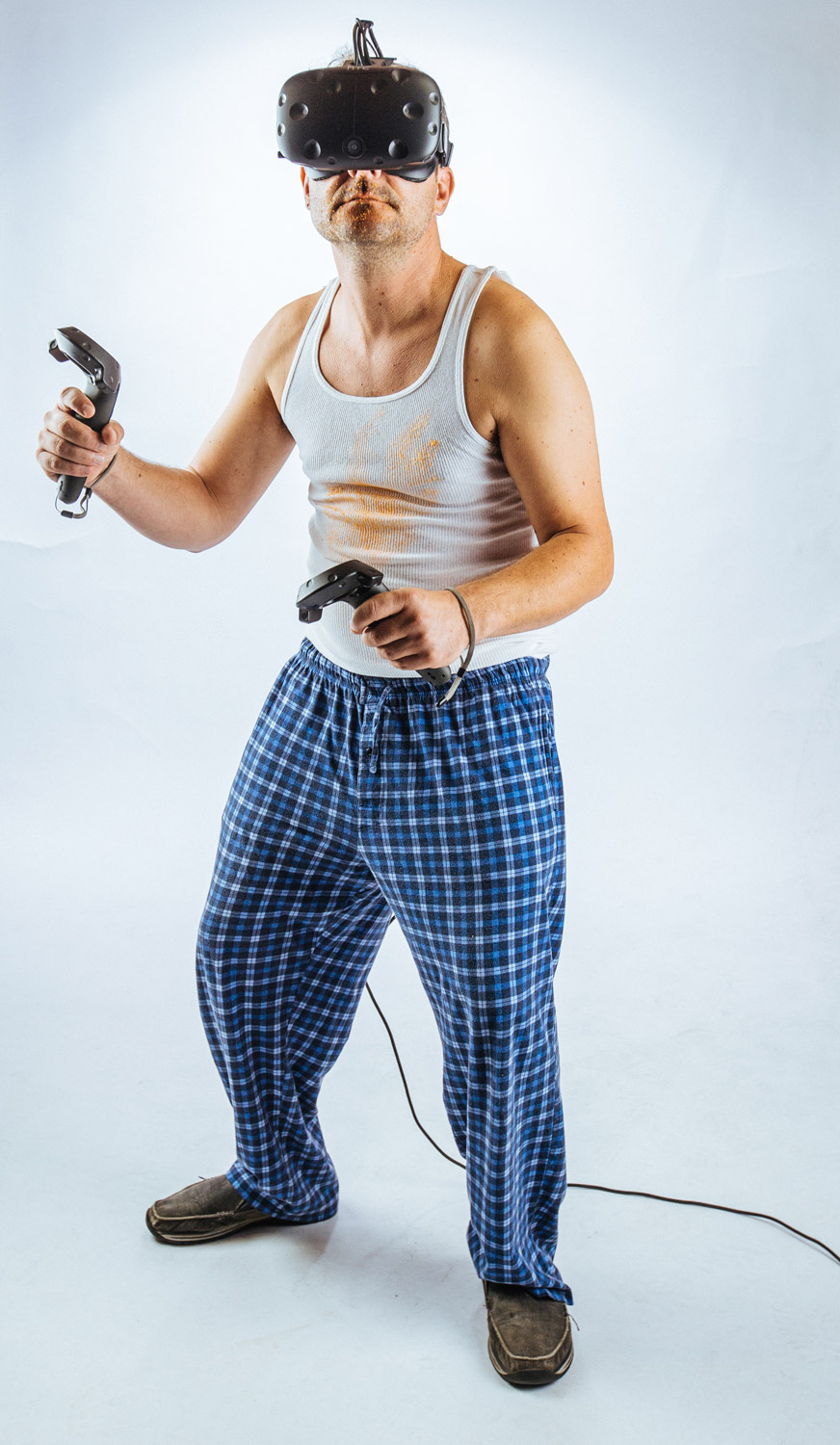This year I’ve had not one but two experiences for which the descriptive powers of language fall woefully short. The first was witnessing the total eclipse of the sun, a cosmic spectacle that ran a hot soldering iron across the length of my cerebral cortex, reducing me to a state of primordial awe that still haunts my waking moments.
That was my big-bang moment, entirely sacred and shared with every person lucky enough to be in the path of totality. My secular big-bang moment, no less profound but entirely private, happened just last week, when my friends Jeff and Kassi hooked me into their brand-new virtual reality system. I don’t give much of a shit about how technologies work; I just want them to perform.
That said, I did ask Jeff to describe, in the crudest terms, what a virtual reality system entails. His system — a high-powered computer hooked into a central processing system (CPU) with an HTC VIVE Steam VR headset, plus a flat-screen TV and two motion sensors mounted on opposite walls, near the ceiling — ran him close to a thousand bucks.
What all of this stuff does, again in layman’s terms, is work together in an intimate and rapid-fire way to create an immersive, three-dimensional platform that reacts to you while you react to it through a nearly seamless continuum of time and space. Basically, a pair of high-definition screens interacts in a staggered way to replicate reality, and dueling sensors shooting iridescent light react to your movements, replicating the actions of a body in space.
Imagine being able to step into an episode of, say, The Walking Dead, and moving around the Georgia countryside with zombies chasing you, all of it as immediate and panoramic as the reality you just left. The only thing missing is the tactile, physical pressure of sensory stimuli, smell and touch and such, with credible impressions of actual pain and pleasure they bring with them, including the threat of death — though you’d be amazed how your mind fills things in. More on that in a minute.
It’s a mistake to think that virtual reality, or at least the desire for it, is a recent phenomenon. Since the first time a kid twirled in circles until falling down, human beings have been trying to derange and alter everyday reality, and Plato’s allegory of the cave shows that the idea of manufactured reality and the shifting scrim of perception have been a concern for thousands of years. Just ask anyone who’s ever dropped a hit of acid.
“So,” Jeff asked me, holding the fancy VR headset in
his hand, “are you afraid of the water?” His girlfriend Kassi snorted and shook her head.
“Nah, man, I ain’t afraid of the water,” I said. “I grew up on the ocean. Bring it on.”
Jeff helped me slip into the headset and placed the headphones on my head. At first, all I saw was a relatively blank space into which materialized a grid of stacked transparent squares described by lines of light. I was inside a box in three dimensions, which I later learned were the limits of the actual living room of Jeff and Kassi’s apartment.
Amazing enough. And then, slowly, but not all that slowly, something happened, and I was standing on the deck of a rusty sunken ship in the dark depths of the ocean. Little fish swam by, and I heard the blurping sounds of air bubbles escaping upward. I walked over to the stern and peered down: the ship was perched on a reef, and I suddenly realized that there was so much sea below me that I couldn’t see the ocean floor.
My knees buckled and I got scared. Maybe I am a bit afraid of water.
Eyewitness testimony is notoriously unreliable, and we hallucinate all the time: Consider how often you think you see a friend, and you’re absolutely positive it’s your friend, but then it turns out not to be your friend. Your brain fills in reality when it’s uncertain of what it’s seeing, and fear and adrenaline work a strange alchemy on the neurological zip of your perceptions. Things that aren’t really there are often really there.
Virtual reality works on these uncertainties by creating a reality convincing enough to cause an almost complete suspension of disbelief in the person strapped to it. On the deck of that ship, I craned my neck upward and suddenly saw the dull orb of the sun glowing on the ocean’s surface, and I said, “Wow.” And then I looked to my right, and there was something looking at me. From about a foot away.
I screamed like a little boy. That blue whale wasn’t just enormous like an enormous simulacrum of a whale you see on television, which isn’t actually big but just looks big within the parameters of the screen and by comparison to its reproduced surroundings. The whale that was eyeballing me was an actual leviathan, in proportion to the reality I inhabited. It was fucking huge.
“Go away,” I told the whale as I backed slowly in the opposite direction, running the risk, in my mind, of plunging over the side. “Go away, go away, go away.”
And then it went away, with a gargantuan flap of its tail that made me jump. I peeled the goggles off. Jeff was looking at me, wide eyed and grinning. He looked like a secret sharer, a man who has just pulled you aside and given you, and you alone, the keys to the teleporter.
From there, I was given a two-hour tour through the current, multiform universe of virtual reality: I bailed out on a battle with zombies that was just way too intense for me; I waged combat with a swarm of bulky gladiators in a game called “Gorn” (gore porn); I entered a 3D replica of Van Gogh’s “Starry Night”; and I fell from a great height, an experience so visceral and convincing that I felt it in every cell of my body, even after I removed the VR headset.
Someone asked me if virtual reality is, indeed, realistic, and I now think I have a decent answer to that. On the one hand, the answer is no: It is not a correlative mirror of what you are now experiencing, meaning its recreation of reality is only as good as the recreation of reality in the latest video game you play; it is limited only by the graphics that are designed digitally, by a series of ones and zeroes. I’m not sure the exactitude of computer animation will ever perfectly mimic the messy organic slog of a real body moving under the weight of gravity. But who knows?
On the other hand, the answer is yes, when you take into consideration the impossibly complex function of our brain as it gathers stimuli and processes it into a perceivable story about where, exactly, we are at any given point in time. Does a dream seem real when you’re dreaming it? There’s your answer.
Virtual reality, in essence, deranges your senses — the dream of the Surrealists made manifest. It alters you by playing on your perceptions to the extent that you convince yourself it’s real. VR exists somewhere in the twilight between dreaming and wakefulness, or better yet, at its intersection, where you dream yourself wide-awake.
Try not to jump when that whale swims up on you.
There are a couple ways you can dive into virtual reality locally: VR Eugene offers on-site tours as well as virtual reality equipment rental, guidance and consultation, brought right into your home (by appointment at 541-554-2456, vreugene.com); also, multiVRse: VR Gaming at 1374 Willamette Street is an arcade with a network of virtual reality stations you can visit and play (open 3 pm to 11 pm every day, 541-221-5172, multivrse.games).

